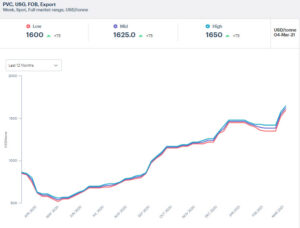Mid-February’s prolonged freeze on the Texas-Louisiana coast has juiced up market commentary as much as it has most petrochemical and polymer pricing.
Just days after the storm, a polyethylene (PE) trader said that the freeze’s effects on regional and global supplies would be “worse than Hurricane Harvey”.
Perhaps so, because not long after, a PE distributor in Europe noted that the winter storm’s effects were just another in a line of production and logistics challenges that have stacked up over the last several months. “All we need now is for aliens to come to earth and take away what’s left of the polyethylene,” said the distributor.
The US monoethylene glycol (MEG) market “is in utter chaos right now,” according to a seller, while another said that supply is so tight that “if [the MEG product is] in a terminal, you can get it, but if not, you can’t”.
This week, a US butanediol (BDO) seller is saying that that market is “at the brink of being completely out of control”.
Statistics bear that out that this is an unprecedented time of challenges for the US petrochemical and plastics supply chains. Take ethylene and its derivatives for example. As of 11 March, about 35% of US ethylene capacity remains offline due in large part to damage incurred from the mid-February freeze. This, combined with the accumulated effects of other production hiccups from 2020, is putting further upward pressure on the price of US spot ethylene, which has already risen by over 90% in the last three months.
Ethylene is the building block for packaging resins used for lightweight consumer goods and consumer goods packaging, as well as construction materials. The meteoric rises in ethylene prices, along with strong demand for packaging and construction materials, have spurred prices for PE, polyvinyl chloride (PVC) and MEG to lofty levels. All of this is occurring at a time of overall economic uncertainty, in which a third US pandemic relief economic stimulus package was signed into law this week.
 Price rises in US ethylene and derivatives are affecting international markets as well. High-density PE (HPDE) spot export prices have jumped more than 61% in the last three months, while US PVC spot export prices have risen almost 18%. While the PVC rise may seem small in comparison to HDPE’s, PVC’s increase has put it at record levels for US spot export prices, an important fact because the US is a top supplier of PVC resin to the rest of the world. Meanwhile, US MEG spot export prices have more than doubled since December 2020.
Price rises in US ethylene and derivatives are affecting international markets as well. High-density PE (HPDE) spot export prices have jumped more than 61% in the last three months, while US PVC spot export prices have risen almost 18%. While the PVC rise may seem small in comparison to HDPE’s, PVC’s increase has put it at record levels for US spot export prices, an important fact because the US is a top supplier of PVC resin to the rest of the world. Meanwhile, US MEG spot export prices have more than doubled since December 2020.
Similar developments have unfolded across the other chains such as propylene and its derivatives, styrenics and phenol/acetone. For many in the supply chain, the current challenges may be the most consequential they have faced, because supplies and production are so disrupted that there is legitimate concern that some will be left in the weeks ahead without the materials needed to run downstream plants. The automotive industry is sharply feeling this in the form of shortages in the polyurethanes (PU) and semiconductor sectors vital to manufacturing today’s fleets of vehicles.
ICIS Senior Analyst Rob Peacock said in a recent article that it would not be surprising if the current supply situation contributed to production disruptions in the auto industry.
“Auto supply chains will struggle with other polymers and plastics, as well as microchips and other bits, but definitely will with PU chemicals as the volume out is relatively large, and the rest of the world has tightened up,” Peacock said.
 The first job of anyone in procurement is not negotiating prices – securing supply is Job 1A, because without raw materials, that business cannot make the products or provide services that keep that business, well, in business. Getting a fair price is Job 1B, but there is no fair price paid without securing that supply. Don’t do Job 1A, and you’re out of a job – period.
The first job of anyone in procurement is not negotiating prices – securing supply is Job 1A, because without raw materials, that business cannot make the products or provide services that keep that business, well, in business. Getting a fair price is Job 1B, but there is no fair price paid without securing that supply. Don’t do Job 1A, and you’re out of a job – period.
Rarely has securing that supply been more difficult than right now. Similarly, ascertaining when these cyclical markets will turn has never been more challenging.
Whether you are a procurement team of one or part of a larger sourcing group, procurement should be a team sport and one in which you source unbiased market insights just as you would raw materials.
Thankfully right now sourcing those insights is easier than finding a cargo of BDO or MEG. ICIS and Chemical Data have plenty on the current supply and demand situations, their effects on North America and global markets, as well as near- and long-term views on how all these will play out.
The current situation may well be “worse than Hurricane Harvey,” but Harvey came and went and this bout of volatility will as well. Through market insight that better informs decisions today and tomorrow, we can help you weather today and be ready for that tomorrow.
Disclaimer: The views in this blogpost should in no shape or form be taken as actual forecasts and are my personal views only.
